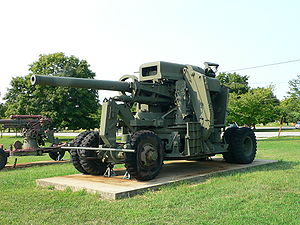120 mm M1 gun
| 120 mm M1 gun | |
|---|---|
 A 120 mm M1 anti-aircraft gun at US Army Ordnance Museum. | |
| Type | Anti-aircraft gun |
| Place of origin | |
| Service history | |
| Used by | U.S. Army |
| Wars | World War II and Korean War |
| Specifications | |
| Weight | 49,000 lb (22 136 kg) |
| Length | 24½ feet (7.39 m) |
| Barrel length | 23½ feet (7.16 m) |
| Crew | A gun commander, a gunner with an eight man squad, and an ammunition chief supervising two ammunition handlers - a total of thirteen men. |
| | |
| Caliber | 120 mm L/60 |
| Barrels | 1 |
| Breech | vertical sliding wedge |
| Recoil | hydropneumatic |
| Carriage | towed |
| Elevation | 80 Deg. |
| Traverse | 360 Deg. |
| Rate of fire | 12 rounds per Min. |
| Muzzle velocity | 3,100 ft/s (945 m/s) |
| Maximum range | 81,000 ft (24,700 m), 57,500 ft (17,500 m) maximum altitude |
The 120 mm Gun M1 was the United States Army's standard super-heavy anti-aircraft gun, complementing the smaller and more mobile 90 mm M3 in service. Its maximum altitude was about 60,000 ft (18,000 m), which garnered it the nickname the stratosphere gun. The 120 served primarily in U.S. defensive roles, although it had been designed to be mobile and saw some action during the Korean War. The 120 was phased out quite quickly in the 1950s with the introduction of the first truly effective missile systems, notably the Nike Ajax.
Contents
History
The Army had originally attempted to make a 120 mm design just after the end of World War I, with a prototype being presented in 1924. The system was considered far too heavy and expensive to be useful, and the project slowed down, although it was never canceled outright.
In 1938 the Army started studying its needs for newer AAA systems, and decided to order new systems for both the heavy and super-heavy role. The former was filled by the new 90 mm gun, which replaced the earlier 3-inch gun then in use, while work on the 120 was dusted off and mated to a new eight-wheel carriage to produce the 4.7-inch M1 when it was accepted in 1940.
Only a small number of 120's were built, about 550 in total. They were mostly used on fixed mounts at various points around the continental U.S., although about fifteen were shipped to the Canal Zone to replace the semi-experimental 105 mm M3 gun that had filled this role. Four were sent, perhaps by mistake, to Northern Ireland. No 120 was ever fired at an enemy aircraft. In 1944 the gun was renamed as the 120 mm Gun M1, as metric naming became the standard.
Like the 90 mm, the 120 was typically operated in a battery of four guns, initially with an associated searchlight and SCR-268 radar, and later with the much-improved SCR-584 radar and M10 Director (Military), and M4 Gun Data Computer that automatically laid the guns as well. the M6 Tractor was used as the prime mover.
Several batteries of 120mm guns were stationed around London in 1944 and 1945 to combat the V1 "Buzz Bomb".
See also
References
- TM 9-2300 Standard Artillery and Fire Control Materiel dated 1944
- TM 9-380
- SNL D-32
External links
| 40x40px | Wikimedia Commons has media related to 120mm gun M1. |